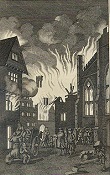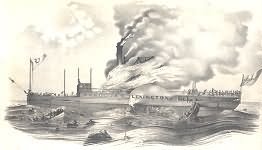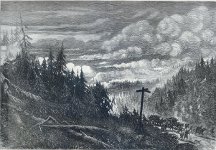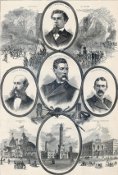
|
|
 |
|
|
|
|

When imagined outside the reality of print consumers' largely urban surroundings, fires could become exotic fuel for imagination. On the prairie, for example, wild fires that licked through grasses fed popular ideas of the west as a place of great danger and drama. Famous fires of history, like the one from which John Wesley was rescued as a child, added to the mystique of well-known people and places and offered an alternative to more staid portraits and landscapes.
Perspective views, or "vues d'optique," are a special type of popular print published in Europe during the 18th century. These prints provided a form of entertainment when viewed through a device called an "optical machine" or an "optique." The most characteristic feature of the perspective views is their emphasized linear perspective, done to further intensify the enhanced appearance of depth and illusionistic space in the prints when viewed through an optique. When displayed in the optique, the prints might transport the viewer into a far away place---an unknown city, or perhaps into the midst of a dramatic bit of contemporary history. Another attribute of these prints is their bright, often crude hand coloring, applied boldly so as to show the tints when viewed through the lens.
A number of perspective prints depicted American scenes at the time of the Revolution for a European audience hungry for news of the events in the British colonies. These images are supposed to show New York, though none is based on any actual New York view, and no buildings or docks such as those shown existed anywhere the city. However, the intent of these prints was more to present a graphic picture for the viewer's interest rather than to record an accurate historical scene. As documents of American history and European printmaking, these are unusual and appealing eighteenth-century prints. This print purportedly shows the burning of New York as the British moved in behind the retreating Americans on September 19, 1776. A dramatic scene even if imaginary. $1,400

Prints from Barnard's New Complete and Authentic History of England. London: Edward Barnard, 1781-83. Engravings. On sheets 14 1/2 x 9. Very good condition.
A pair of historical prints from Edward Barnard's History of England. This delightful history was described on one of the prints as "A Work Universally Acknowledged to be the Best Performance of the Kind,-on account of It's Impartiality, Accuracy, New Improvements, Superior Elegance, &c." It was issued at the end of the eighteenth century in response to the growing demand for works on all subjects by a newly educated reading public in England. The history was full of prints on all aspects of English history, including these two fire prints.
The dramatic event depicted is the burning of the Masonic Hall, a gothic brick and marble structure designed by William Strickland and built to much acclaim in 1809-10. This striking edifice, located on Chestnut Street above Seventh, burned in spectacular fashion in 1819, watched by a large crowd of spectators. The print was issued by Kennedy & West just a few months after the conflagration, a very short time to bring out a print of such an event. This rousing print well captures the drama of the scene, conveying the excitement of this Philadelphia disaster from over a century and a half ago, and testifying to the ability of the artists and engraver.
The view was a collaboration of two artists, John L. Krimmel and Samuel Jones. Little information is available on the life and works of Jones. He seems to have been commissioned by the original publishers to paint the background for the scene. For the figures in the foreground, John L. Krimmel was hired. Krimmel was a native of Germany, who came to the United States in 1810, settling in Philadelphia, where he painted portraits, miniatures, and good-natured street scenes. Krimmel is particularly known for his delightful treatment of the latter, and this print is a fine example of his style. Krimmel was able to graphically capture the frenzy of activity at the scene, the details and furor of the fire illustrated with great intricacy and emotion. The print was aquatinted by John Hill, the most skilled etcher in the United States. Hill (1770-1850) was an Englishman who had just settled in Philadelphia, and he was soon to go on to other projects which would bring him great fame. $550
![]() Click here for more views of Philadelphia.
Click here for more views of Philadelphia.

"Awful Conflagration of the Steam Boat Lexington in Long Island Sound." 1840. Lithograph. 6 1/2 x 11 1/2. Close margins, but complete. Very good condition.
The "Awful Conflagration" of the Lexington in Long Island Sound on January 13th, 1840, with its large loss of life, was an event that attracted much attention in New York City and area. This spurred the production of broadsides and lithographed images of the disaster, most famously one by Nathaniel Currier (cf. above) that is supposed to have been one of the foundations of his successful career. This was not, however, the only "rush print" made of the burning of the Lexington and here is an unusual and unattributed lithograph of the same scene. The title is similar to the Currier print, but the image is quite different. It was undoubtedly issued within a short time of the event and was aimed at the market created by the public fascination with this famous disaster. $575
![]() Click here for more marine prints.
Click here for more marine prints.
Ferogio. "Fire in the Country." Engraved by F. E. Jones. Cincinnati: F. C. Middleton for The Ladies' Repository, 1854. Mezzotint with line engraving. 4 7/8 x 7 3/4.
In the urgent flight of the farm family, the artist conveys the great danger posed by a fire in the open prairie. For many of the rural Midwestern subscribers to The Ladies' Repository, such a fire was never far from everyday thoughts and concerns. $45
The Great Fire In Chicago. January 28 1868. New York: Harper's Weekly, 15 February 1868. 9 x 9. Wood engraving. Very good condition.
Even before the fire of 1871, Chicago was prone to conflagrations. Like other cities, its concentration of people, fire-based lighting and heating, and wooden structures meant that potential for disaster was always present. The tragedy of January 1868 is here illustrated and briefly described. $75

"The Great Forest Fire in America: View near Fox River." London: The Illustrated London News, 4 November 1871. Wood engraving. 8 3/8 x 12 3/8.
In addition to covering the Chicago fire, The Illustrated London News noted that fire had been wreaking havoc in other parts of the United States, as well. This scene shows forests along the Fox river in either Wisconsin or Illinois. $50
"A Forest Fire in America." London: The Illustrated London News, 28 November 1871. Wood engraving. 19 1/4 x 12 1/4.
In addition to covering the Chicago fire, The Illustrated London News noted that fire had been wreaking havoc in other parts of the United States, as well. Here, the paper illustrates one of the many forest fires that had been raging in Michigan's lumber regions, where log yards and saw-mills became tinderboxes for destructive blazes. $95
J. J. Harley. "The Boston Fire -- Washington Street, Looking South, With Ruins of the Chickering Building and Globe Theatre on the Left." New York: Harper's Weekly, June 14, 1873. Wood engraving. 14 x 9. $110
Julian Rix. "A Forest Fire." New York: Harper's Weekly, August 21, 1886. 13 3/8 x 9. Wood engraving. Very good condition. $45
As an integral (necessary) part of a town of any scale, they also became fodder for satire. Visual satirists, who used permutations of recognizable types to lampoon their subjects, used the archetypal fireman to make jokes, often racially oriented. In series of prints mocking African-American communities, popular print makers like Currier & Ives included a fire brigade in the images marketed as comical chromolithographs to a white, middle-class audience.
In fact, Archibald Robertson, who assembled and annotated the Memoir's illustrations, claimed that the print of Engine No. 13 was "the first engine that was lithographed, and that by Mr. Imbert." Two fine prints; important for both subject matter and printing method.

Louis Maurer was a German immigrant who produced some of Currier & Ives most enduring images. In 1854, Nathaniel Currier published four prints after Louis Maurer entitled "The Life of a Fireman." This series became immensely popular and two more prints were added to the series by two other artists after Maurer left the Currier firm. Eventually the entire series was republished by Currier in the 1880s with the publisher's name changed to "Currier and Ives" on five of the six prints.
These six prints are most likely re-strikes from the early 20th century, since the images are darker in appearance than the earlier impressions and the paper is not the type used by Currier and Ives. When the firm was liquidated in 1907 the old lithographic stones were sold and a few of the clipper ship prints were restruck and hand colored. Most likely another individual did the same for the "Life of a Fireman" series. Even though these are early 20th century hand colored restrikes it is unusual to find the complete set of six prints in such fine condition. For the set of six: $16,000









![]()
For further information, please contact:

![]()
106 E. Lancaster Avenue, Lower Level
Wayne, PA 19087 USA
610.808.6165
PhilaPrint@PhilaPrintShop.com ![]()
©The Philadelphia Print Shop, Last updated July 13, 2021